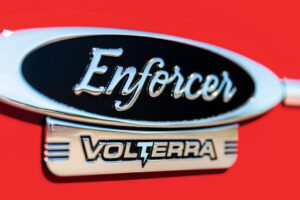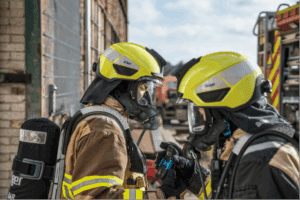Hoods made using DuPont™ Nomex Nano Flex deliver optimal filtration efficiency and comfort to improve protection against toxic particles
New research from DuPont Personal Protection found that nanofiber-based nonwoven hoods give firefighters near-total protection against toxic smoke particulates. Hoods made using Nomex® Nano Flex displayed over 99% particulate filtration efficiency while achieving optimal breathability and thermal insulation.
Firefighters’ risk of exposure to harmful substances has increased in recent years. In June 2022, the International Agency for Research on Cancer (IARC) officially classified firefighters’ occupational exposure as carcinogenic (Group 1). Toxic substances include gas, liquid, and smoke particulates that can penetrate personal protective equipment (PPE). A conventional hood made of two layers of loose knits isn’t an effective barrier against these particulates. A recent study suggests that the neck skin is the most exposed part of a firefighter’s body, absorbing combustion products. The penetration rate can even be several times greater when temperature and humidity are extremely high as experienced during firefighting.
Two barrier types can block smoke particulates from entering a firefighter hood which is typically made with a polytetrafluoroethylene (PTFE) membrane or with a nanofiber-based nonwoven like Nomex® Nano Flex. Both are flame-resistant and stable at high temperatures. The PTFE membrane is a microporous film that blocks particulate ingress by making pores significantly smaller than the size of particles. By contrast, a nanofiber-based particulate barrier is a nonwoven consisting of a network of continuous nanofiber filaments that entrap smoke particles in its tortuous maze.
Tests conducted by DuPont found that hoods made using a Nomex® Nano Flex nanofiber particulate barrier had over 99% particulate filtration efficiency, including at the seam, even after 250 washes. The same hoods were then subjected to a smoke simulation test in a room filled with fluorescent aerosols. The hood made with Nomex® Nano Flex showed no signs of submicron particle penetration, while the hood made without a nanofiber-based nonwoven displayed significant penetration.
In addition, DuPont compared a PTFE membrane and a nanofiber-based barrier for breathability and comfort. In the fire service, comfort is typically measured by air permeability and resistance to evaporative heat transfer (RET). A material having higher air permeability and high total heat loss (THL) indicates comfort and breathability. As shown in Figures 3 and 4, DuPont found that hoods made with Nomex® Nano Flex had significantly higher air permeability and THL than PTFE hoods. Placing a nanofiber nonwoven between two layers of a knit firefighter hood may also improve thermal insulation by 10% to 20%.
All these findings confirm that firefighter hoods made with Nomex® Nano Flex exceed the requirements set by the latest National Fire Protection Association (NFPA) 1971-2018 standard. According to the standard, a hood (seam included) shall meet not only the minimal 90% filtration efficiency but also THL ≥325 W/m2 and thermal protection performance (TPP) ≥20 cal/cm2.
DuPont’s findings corroborate a 2021 study of firefighting hoods. The study concluded that soot contamination levels measured from neck skin were lower when firefighters wore laundered particulate-blocking hoods compared to when they wore new knit hoods.
“Firefighting will always be a dangerous profession; however, important advancements in PPE such as nanofiber-based hoods can make a difference.” Comments Jian Xiang, Global Technology Leader for Emergency Response at DuPont Personal Protection. “Nanofiber-based hoods have been proven in the lab and, more importantly, in real-world firefighting conditions. They provide superior protection against particulate penetration and are much more comfortable to wear.”
To read more articles, see our last issue here.
Never miss a story… Follow us on:
International Fire Buyer
@Firebuyer
Fire Buyer
Media Contact
Rebecca Spayne Managing Editor, International Fire Buyer
Tel: +44 (0) 1622 823 920
Email: [email protected]




































